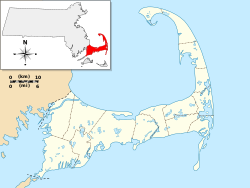
Oak Bluffs is a town located on the island of Martha's Vineyard in Dukes County, Massachusetts, United States. The population was 5,341 at the 2020 United States Census. It is one of the island's principal points of arrival for summer tourists, and is noted for its "gingerbread cottages" and other well-preserved mid- to late-nineteenth-century buildings. The town has been a historically important center of African American culture since the eighteenth century.

Kanuga Conference Center is affiliated with the Episcopal Church in the United States of America and the Anglican Communion. It is located on 1,400 acres (5.7 km2) near Hendersonville, North Carolina, with scenic Kanuga Lake at its center. Yearly, more than 35,000 guests utilize the facilities, which include the conference center, Camp Kanuga, Camp Bob, and the Mountain Trail Outdoor School.

Wesleyan Grove is a 34-acre (14 ha) National Historic Landmark District in Oak Bluffs, Massachusetts on the island of Martha's Vineyard. Named after John Wesley, the founder of the Methodist Church. Also known as the Martha's Vineyard Campmeeting Association (MVCMA) or the Campgrounds, it was the first summer religious camp established in the United States. It is famous for its approximately 300 colourful cottages in a style now described as Carpenter Gothic.

The Osterville Baptist Church is an historic Baptist church building at 824 Main Street in the Osterville village of Barnstable, Massachusetts. The white clapboarded wood-frame structure was built in 1837 for a congregation formed two years earlier. It is one of the older buildings in Osterville, and is a fine example of the Greek Revival with Gothic Revival elements. The church was listed on the National Register of Historic Places in 1987.

The West Chop Club Historic District is a historic district in Tisbury, Massachusetts, on the island of Martha's Vineyard. The district represents a well-preserved planned summer resort community of the late 19th century. Located in and around Iroquois Avenue, the district encompasses the northernmost portion of West Chop, a peninsula that separates Vineyard Sound and the sheltered waters of Vineyard Haven Harbor, an area that was developed by the West Chop Land Company in the 1880s. The land is now owned by the West Chop Land Trust and managed by the private West Chop Club. The district was listed on the National Register of Historic Places in 2007.

The Ayer Main Street Historic District encompasses most of the historic central business district of Ayer, Massachusetts. It extends along Main Street between Park and Columbia Streets, and was mostly developed between 1872 and 1898 as a hub of railroad and roadway-based economic activity. The district was listed on the National Register of Historic Places in 1989.

The Benjamin Baker Jr. House is a historic house at 1579 Hyannis Road in Barnstable, Massachusetts. Built about 1828, it is a well-preserved example of a Federal period "half Cape". It was listed on the National Register of Historic Places in 1987.

The Yarmouth Camp Ground Historic District is a historic district encompassing a religious summer camp meeting ground in Yarmouth and Barnstable, Massachusetts. The core of the camp ground was purchased in 1863 by the Sandwich District Camp Meeting Association, a Methodist Episcopal organization, and was operated until 1939. The area contains a well-preserved collection of predominantly residential buildings built during this period; it was listed on the National Register of Historic Places in 1990.

The Wianno Historic District is a historic district in the Osterville section of Barnstable, Massachusetts. It encompasses a well-preserved summer resort area for the wealthy that was first developed in the late 19th century, focused around the Wianno Club, built in 1881 on the site of an earlier resort hotel. The 40-acre (16 ha) district has a significant number of well-preserved Shingle style and Colonial Revival houses. Architect Horace Frazer designed the Wianno Club, as well as a number of the private residences in the district. The district is roughly bounded by East Bay Road, Wianno and Sea View Avenues between Nantucket Sound and Crystal Lake. It was added to the National Register of Historic Places in 1987.
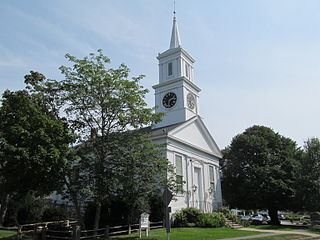
The Centerville Historic District is a historic district encompassing the heart of the village of Centerville in Barnstable, Massachusetts. The district extends along Main Street from a point north of its junction with Old Stage Road and Park Avenue, south to the junction with Church Hill Road. Most of the buildings in the district were built in the middle decades of the 19th century, although its oldest building, the Austin Bearse House, was built c. 1690. The area's growth was spurred by the relocation in 1826 of the Congregational Church building to its present location. The district was listed on the National Register of Historic Places in 1987.

The Cotuit Historic District is a historic district encompassing the heart of the village of Cotuit in Barnstable, Massachusetts. It extends along Main Street from Lowell Street in the north to Sea Street in the south, and includes portions of Ocean View Avenue and properties on adjacent roads. The oldest properties date to the late 18th century, but saw its greatest development during the height of the area's maritime industry in the mid 19th century. In the late 19th and early 20th century the area saw new development as a summer resort area. The district was listed on the National Register of Historic Places in 1987.

The Falmouth Village Green Historic District is a historic district encompassing the historic village center of Falmouth, Massachusetts. It is centered on the triangular village green formed by Main Street, West Main Street, and Hewins Street, and extends south on Locust Street to the Old Town Cemetery. This area has been the town center since 1756, and is architecturally dominated by late Colonial and Federal period buildings. The district was added to the National Register of Historic Places in 1996.

The Hyannis Port Historic District encompasses the historic heart of Hyannis Port, Massachusetts, an area that was intensively developed as a summer resort community beginning in the later decades of the 19th century. The district is about 100 acres (40 ha) in size, and extends from nearly Scudder Avenue in the west to Ocean Avenue in the east. It is bounded on the south by Nantucket Sound, and on the north by Grayton, Edge Hill, and Ocean Avenues. The district was added to the National Register of Historic Places in 1987.

The Mill Way Historic District encompasses a residential area significant in the development of the maritime industry in Barnstable Village, Massachusetts. It includes thirteen houses, ten on Mill Way and three on adjacent Freezer Road, just north of the Old King's Highway. The district was listed on the National Register of Historic Places in 1987.
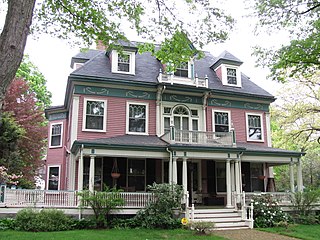
The Crystal Lake and Pleasant Street Historic District encompasses a streetcar suburban residential subdivision developed between 1860 and 1895 in Newton, Massachusetts. The district roughly bounded by the Sudbury Aqueduct, Pleasant Street, Lake Avenue, Webster Court, and Crystal Street. The subdivision was laid out in the 1850s after the Boston and Charles Railroad line was extended through Newton from Brookline. The district was listed on the National Register of Historic Places in 1986.

Since 1895, Fountain Park has hosted an annual Chatauqua to promote religious, social and educational activities. It was added to the National Register of Historic Places on December 7, 2001.

The Chester Heights Camp Meeting Historic District is a historic Methodist camp meeting and national historic district located in Chester Heights, Delaware County, Pennsylvania. The district includes 101 contributing buildings, which were designed in the vernacular camp meeting style of architecture; additional notable examples of the Gothic Revival and Queen Anne styles also are present here. Public buildings include the contributing Tabernacle (1878), Dining Hall (1900), Youth Tabernacle (1909, and dormitory. Most of the contributing buildings are cottages, which were built roughly between 1876 and 1920.
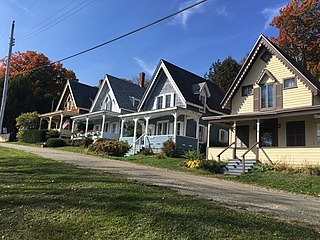
The Bayside Historic District encompasses the historic core of a former religious summer camp meeting community in Northport, Maine, USA. It includes the original grounds of the Northport Wesleyan Grove Camp Meeting, established in 1848, with most of surviving architecture built between about 1870 and 1920. It is the largest surviving such area in the state, and was listed on the National Register of Historic Places in 1996. It is now the heart of the Bayside village, a secular seaside summer resort community.
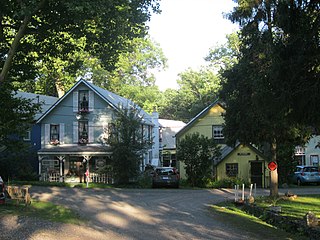
The New Haven District Campground, also known as the Plainville Campground, is a historic Methodist camp meeting site on Gladding Avenue in Plainville, Connecticut. Opened in 1865, the campground was used by Connecticut Methodists to partake in the 19th-century trend of religious and recreational camp meetings, and is now a secular community of summer homes. The campground was added to the National Register of Historic Places on May 19, 1980.

The Advent Camp Meeting Ground Historic District encompasses the early surviving elements of a religious summer camp meeting ground in Hartford, Vermont. Founded in 1887, it is one of a small number of camp meetings surviving from the 19th century in the state, and the only surviving one run by the Advent Christian General Conference. It was listed on the National Register of Historic Places in 2017.

